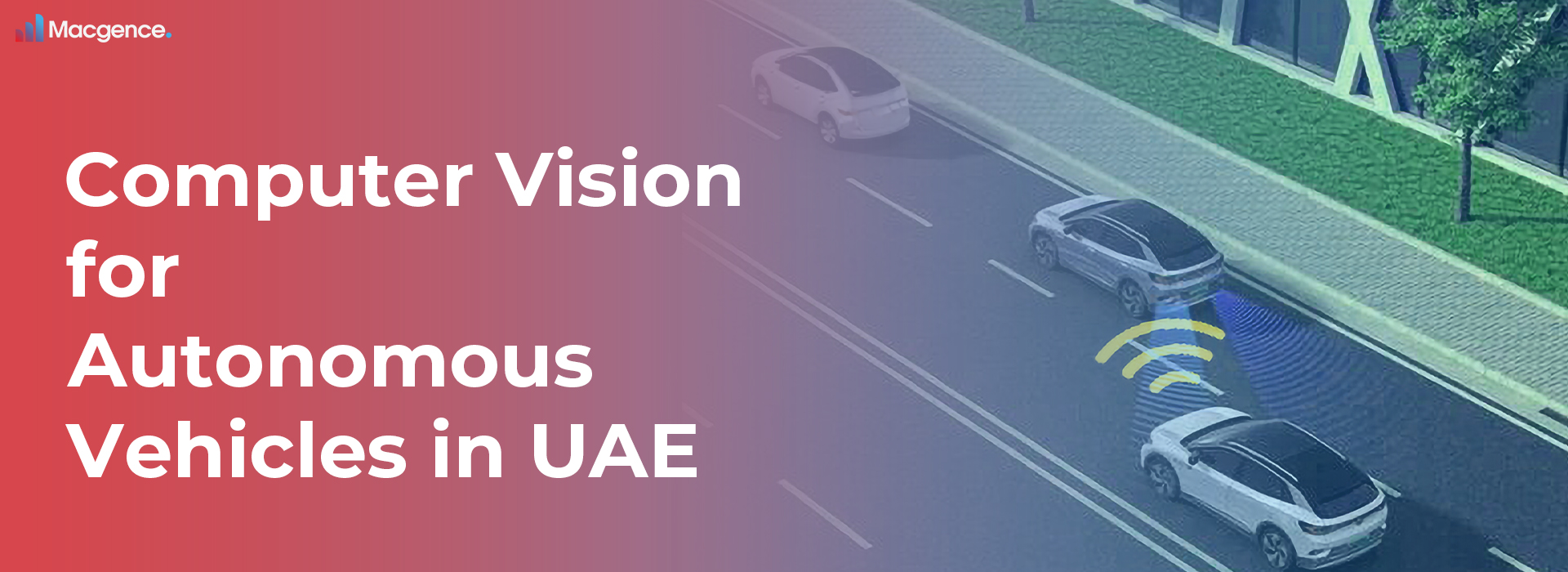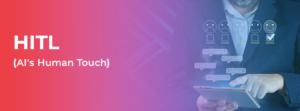Exploring the Future of Computer Vision for Autonomous Vehicles in UAE
Can a car develop eagle eyesight to drive on complex roads safely? Though it sounds like science fiction, this fantasy is becoming a reality thanks to recent developments in artificial intelligence services. With computer vision for autonomous vehicles in UAE, passengers may be securely transported to their destination by digital eyes in self-driving automobiles. Buckle up as we explore the reasons why computer vision for autonomous vehicles in UAE is important.
In this article we’ll explore –
- Introduction to computer vision technology in autonomous driving
- Workflow breakdown: from real-time data capture to split-second decision-making
- Applications: object recognition, 3D mapping, smart safety features
- Benefits: enhancing navigation, ensuring passenger safety, improving efficiency
- Challenges: high-speed resolution, illumination, and background variability & more
What is Computer Vision for Autonomous Vehicles?
Machines can already read and comprehend images and videos from the actual world thanks to computer vision, a type of artificial intelligence. Computer vision systems aid with driving decisions in autonomous cars by processing and analyzing visual data from cameras, Lidar, and sensors. To assist the vehicle in navigating the roadway effectively and suitably, these systems detect and categorize objects, lane markers, traffic signals, and other relevant functions. Developments in computer vision are crucial to creating safer, more dependable, and independent driving systems since the area is always changing with autonomous car technology.
Workflow of Computer Vision for Autonomous Vehicles in UAE

1. Capturing Data:
Cameras and sensors capture live photographs and videos of the surroundings around the car.
2. Handling:
Visual input is analyzed by onboard processors, which recognize motions, patterns, and forms.
3. Acknowledgment
Semantic segmentation is a technique computers use for autonomous driving to deconstruct a visual environment and categorize items such as people, automobiles, lane markings, and traffic signals.
4. Making decisions:
Based on what the car’s internal computers recognize, the AI algorithms determine whether to stop, move, or accelerate.
5. Take Action:
These choices are translated by the vehicle into actual movements that drive it safely along the road. Computer vision converts static pictures into useful information, enabling safe and effective navigation.
Benefits of Computer Vision for Autonomous Vehicles in UAE
Object Recognition:
To protect passengers, autonomous cars employ cutting-edge technology to recognize and locate objects on the road. They use sensors and cameras to gather data and create 3D maps, allowing them to recognize items such as pedestrians, other vehicles, and traffic signals. As a result, this enables them to safely navigate the road and avoid potentially harmful incidents.
3D Mapping:
To create 3D maps, autonomous cars are outfitted with cameras that can take pictures in real time. By using these maps, the cars are better able to comprehend their environment and give their passengers a safer and more enjoyable ride. The autonomous car can also properly navigate its driver and reroute itself to avoid any crashes with the help of 3D maps. Taken as a whole, it guarantees fun and safety.
Smart Airbag Function:
Computer vision is a potent instrument that continually analyzes and interprets data from its surroundings. By using its predictive power, it can identify possible collisions or accidents before they happen and activate safety systems like airbags beforehand, giving its occupants the utmost level of security. Intelligent technology like computer vision makes sure that passengers are always safe.
Lane Line Detection:
To ensure safe travel, self-driving cars need computer vision with deep learning technologies. Deep learning makes it possible for segmentation techniques to identify lane lines, assisting the car in staying in its lane and determining when to turn and curve.
Driving in Low Light:
Computer vision is used by self-driving cars to detect and adapt to changing lighting conditions, including variations brought on by topography, routes, and time of day. In particular, LIDAR, HDR sensors, FMCW radars, SAR, and thermal cameras commonly detect low-light conditions and then make the necessary adjustments. Without these advanced algorithms, driving would be hazardous and challenging, as visuals would frequently be hazy in low-light scenarios.
Training Data:
To guarantee safe driving circumstances, modern autonomous cars use data sets on the location, road and traffic conditions, terrains, and the population in the region. Deep learning models may also be trained using this data. People may use cameras to take pictures of traffic lights at different intersections, which can then help teach computer vision systems to verify traffic signals. The data sets can also help in classifying and identifying different roadside artifacts.
Car tracking:
By using sophisticated computer vision techniques, including bounding box detention, roadways may be kept an eye out for cars that have previously been identified. Then, with the use of this data, road safety may be improved by monitoring other drivers’ actions and forecasting potential future events.
Discover the Difficulties of Using Computer Vision in Autonomous Vehicles
High-Speed Resolution: To swiftly and precisely identify any possible barriers, autonomous cars mainly rely on high-precision computer vision systems. At rates that are comparable to the vehicle’s operating pace, the systems must also be able to recognize and decipher signals from their environment in real-time.
Illumination and Background: Vision systems must be able to analyze and interpret photos acquired against a variety of backdrops, as well as capture high-resolution images in extremely low light and harsh environmental circumstances.
Object Detection Accuracy: Autonomous cars must be able to identify and detect a variety of items that might be in their immediate environment. To achieve this, computer vision systems must have real-time object detection and identification capabilities.
False-positive Detection: Computer vision systems need to be able to distinguish between items that look alike but could be of a different kind. If they can’t, they might categorize the objects wrongly and produce false-positive detections.
Ruggedness and Stability: Dust, humidity, vibration, temperature, and other extreme circumstances must not pose a problem for autonomous vision systems. By ensuring this, we can guarantee that the technologies remain functional in the environments designed for these cars to operate.
Choose Macgence as your partner in Computer Vision for Autonomous Vehicles

A significant part of computer vision for autonomous car technology is machine learning. However, they need to have a strong data annotation process with quality control procedures and seamless iteration cycles in order to guarantee the performance and security of a model as complicated as an autonomous car. Macgence is made to assist businesses in supplying extremely high-quality data. You can feed this into AI models to accelerate their output by several times. Presenting the model with a variety of inputs raises the likelihood that it will produce accurate and significant findings.
Macgence is ready to be your partner in this new era of computer vision for autonomous car innovation, especially as we stand on the brink of a revolution in computer vision. To further strengthen the computer vision model, we carefully take into account a variety of scenarios and edge circumstances.
Conclusion:
Computer vision is undeniably a shining light of hope and possibilities for autonomous driving. Its applications are numerous and revolutionary, ranging from split-second decision-making to real-time data gathering. Furthermore, the promise of safer roads and increased mobility continues to spur constant innovation, despite persistent challenges like high-speed resolution. As we move forward, let’s approach the road ahead with hope and resolve while embracing the autonomous driving of the future. As we move forward, let’s approach the road ahead with hope and resolve, fully embracing the future of autonomous driving. We are setting out on a path toward safer, smoother, and more efficient transportation, with computer vision as our guide. Through collaboration, we can create a world where the future is within reach, and opportunities abound.
FAQs
Ans: – The car can effectively make educated judgments to prevent collisions by efficiently using computer vision to identify and recognize objects, lane markers, as well as other dangers.
Ans: – Computer vision systems consistently ensure dependable performance in a range of weather scenarios by proactively adapting to changing environmental circumstances through the use of sophisticated algorithms and sensor fusion techniques.
Ans: – To ensure scalability and efficiency when integrating computer vision technologies into their pipeline for developing autonomous vehicles, businesses might work with specialist vendors or build in-house expertise.
You Might Like
February 28, 2025
Project EKA – Driving the Future of AI in India
Artificial Intelligence (AI) has long been heralded as the driving force behind global technological revolutions. But what happens when AI isn’t tailored to the needs of its diverse users? Project EKA is answering that question in India. This groundbreaking initiative aims to redefine the AI landscape, bridging the gap between India’s cultural, linguistic, and socio-economic […]
April 1, 2025
The Strategic Benefits of Partnering with Macgence for Model Evaluation and Validation
In the rapidly evolving AI landscape, ensuring robust model performance is not just an advantage—it’s a necessity. For businesses leveraging AI/ML technologies, partnering with a specialized validation partner like Macgence can mean the difference between unreliable prototypes and enterprise-grade AI solutions. At Macgence, we bring unmatched expertise in AI model evaluation and validation to help […]
March 24, 2025
Natural Language Generation (NLG): The Future of AI-Powered Text
The ability to generate human-like text from data is not just a sci-fi dream—it’s the backbone of many tools we use today, from chatbots to automated reporting systems. This revolution in artificial intelligence has a name: Natural Language Generation (NLG). If you’re an AI enthusiast or a tech professional, understanding NLG is essential for keeping […]
March 24, 2025
HITL (Human-in-the-Loop): A Comprehensive Guide to AI’s Human Touch
The integration of Artificial Intelligence (AI) in various industries has revolutionized how businesses operate. However, AI is not infallible, and many applications still require human intervention to enhance accuracy, efficiency, and reliability. This is where the concept of Human-in-the-Loop (HITL) becomes essential. HITL is an AI training and decision-making approach where humans are actively involved […]


 Previous Blog
Previous Blog







